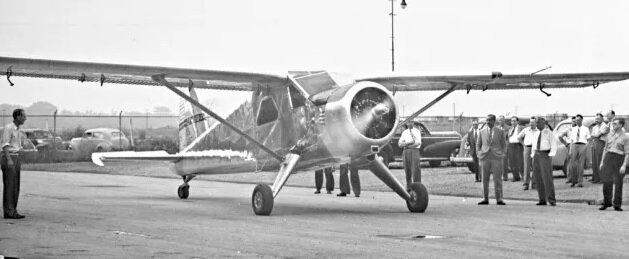You are using an out of date browser. It may not display this or other websites correctly.
You should upgrade or use an alternative browser.
You should upgrade or use an alternative browser.
Early Drawing to De Havilland Canada DHC-2
- Thread starter hesham
- Start date
- Joined
- 25 July 2007
- Messages
- 4,299
- Reaction score
- 4,189
... looks almost like a different aircraft...
It does. But, actually, aft of the firewall, the DHC-2 prototype (CF-FHB-X) was virtually identical. The Beaver tail didn't get its distinctive, curved dorsal fin extension until later (also true in the development of both the Chipmunk and Otter).
The team under 'Jaki' Jakimiuk produced the original, Gipsy Queen-powered design to meet the corporate requirement that all future de Havilland airframe designs be powered by DH engines. Gipsy Queen refinement was slow so, fortunately, the more readily-available and more powerful R-985 was substituted.
Attachments
The Beaver owed a lot to the engineers of the Ontario Provincial Air Service and to many Canadian bush pilots. Indeed, their preference for an American engine rather than a British one, for example, led to the abandonment of the Gipsy Queen in favour of the Pratt & Whitney R-985 Wasp Junior, seemingly available at a discount as war surplus.
De Havilland Canada allegedly decided to switch engines as its engineering director travelled to England to examine the Gipsy Queen more closely.
De Havilland Canada allegedly decided to switch engines as its engineering director travelled to England to examine the Gipsy Queen more closely.
- Joined
- 11 March 2012
- Messages
- 3,244
- Reaction score
- 3,171
Yes.The Beaver owed a lot to the engineers of the Ontario Provincial Air Service and to many Canadian bush pilots. Indeed, their preference for an American engine rather than a British one, for example, led to the abandonment of the Gipsy Queen in favour of the Pratt & Whitney R-985 Wasp Junior, seemingly available at a discount as war surplus.
De Havilland Canada allegedly decided to switch engines as its engineering director travelled to England to examine the Gipsy Queen more closely.
In the immediate aftermath of World War 2 Pratt & Whitney of Canada purchasing officers visited many of the war-surplus auctions to buy up all of the Anson Mark V trainers. The plywood airframes were promptly scrapped while R-985 engines went back to the factory in Longueuil, Quebec for over-haul.
Those war-surplus engines also powered most of the post-war built Beechcraft C-45 Expeditors.
R-985's biggest advantage was a massive increase in horsepower over Gypsy Queen (450 hp. vs. 208 hp.). That massive increase in power made possible rapid acceleration and STOL take-offs. Note how the 1967 vintage Turbo-Beaver III started with a 578 hp. Pratt & Whitney of Canada PT6A-6 or -20. Most of the Beavers still working in B.C. have been converted to turbo-prop engines.
Last edited:
- Joined
- 18 June 2009
- Messages
- 1,412
- Reaction score
- 2,493
You can see the first production Beaver and first Turbo Beaver at the Canadian Bushplane Heritage Center in Sault Ste. Marie, Ontario, Canada: https://bushplane.com/
This museum has many rare types including the DeHavilland Beaver, Otter, Dragon Rapide, Fox Moth, Noordun Norseman, Fairchild Husky, Fokker Super Universal and Tri-Motor, and Canadair CL-215.
This museum has many rare types including the DeHavilland Beaver, Otter, Dragon Rapide, Fox Moth, Noordun Norseman, Fairchild Husky, Fokker Super Universal and Tri-Motor, and Canadair CL-215.
- Joined
- 25 July 2007
- Messages
- 4,299
- Reaction score
- 4,189
... Most of the Beavers still working in B.C. have been converted to turbo-prop engines.
Really? I see nothing but piston Beavers on floats were I am (flying with Harbour Air and two local operators). And if I'm in some kind of R-985 time warp, I wanna stay!
We do have a Turbo-Otter conversion that appears at our local water aerodrome but I've never seen a Turbo-Beaver here.
Incidentally, the prototype of the Beaver is on display at the Canada Aviation and Space Museum, in Ottawa.
Similar threads
-
-
Bendix Aircraft's forgotten postwar designs
- Started by Stargazer
- Replies: 6
-
-
-
The Smith B-2 "Arrowhead" Safety plane: Glenn Curtiss's last project
- Started by Stargazer
- Replies: 5


